Havasuapai is truly an oasis in the middle of the desert. The best way to describe this magical place is to say that if the Grand Canyon and Hawaii had a baby, and they would name it Havasupai. Decades ago, this place was almost unheard of, but thanks to this digital era (and social media!) in which we now live in, Havasupai is world famous and highly sought-out as an adventure destination.
And for good reason–it’s remote, breathtakingly beautiful, and an adventure just getting there. This will be one place you will want to return to over and over again. That’s why we put together the ultimate guide to hiking Havasupai with kids.
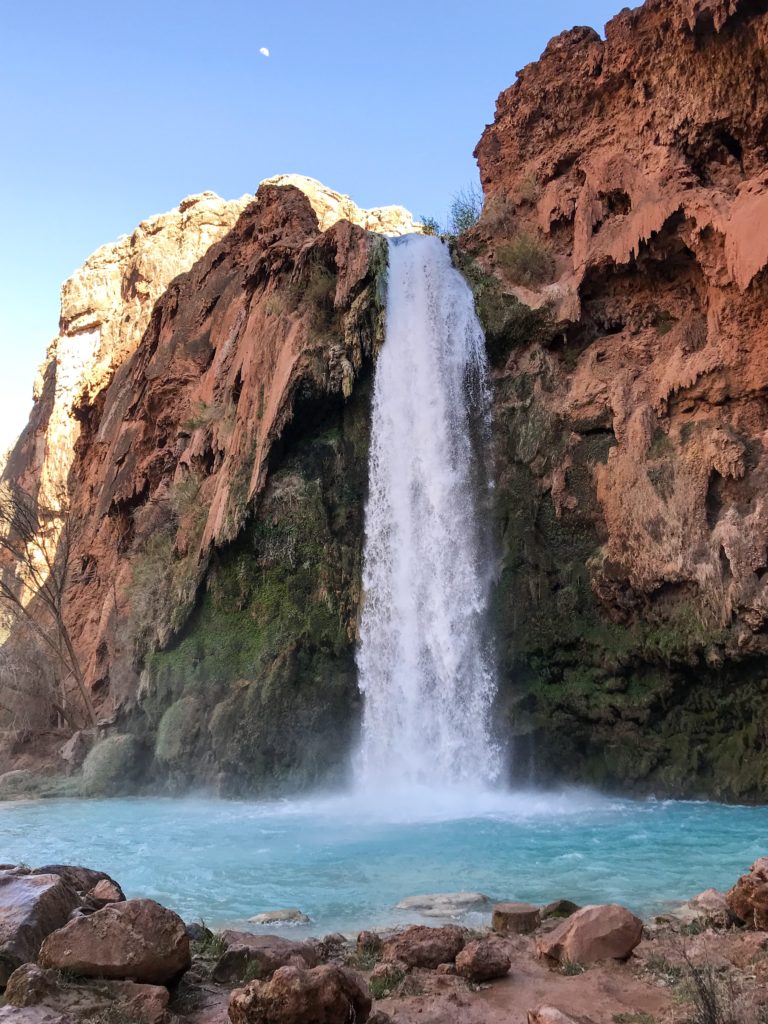
It’s hard to believe that this place exists and yes, the water really is that blue!
We’ve created this guide for hiking to Havasupai, specifically with kids in mind, because when we were planning this trip, we didn’t find a lot of helpful information out there on doing this hike with KIDS. We also want to show parents that making the trek to Havasuapai is do-able with children of all ages if you just plan and prepare ahead. This guide can also be useful for anyone wanting to make the trek though, especially if you’re a first timer and a little intimidated by it all.
Below you will find some valuable information on hiking Havasupai with kids, to include our top tips, basic info to help you plan (such as securing permits), as well as a complete packing list. We also have included a couple of sample itineraries depending on how many days you decide to go for.
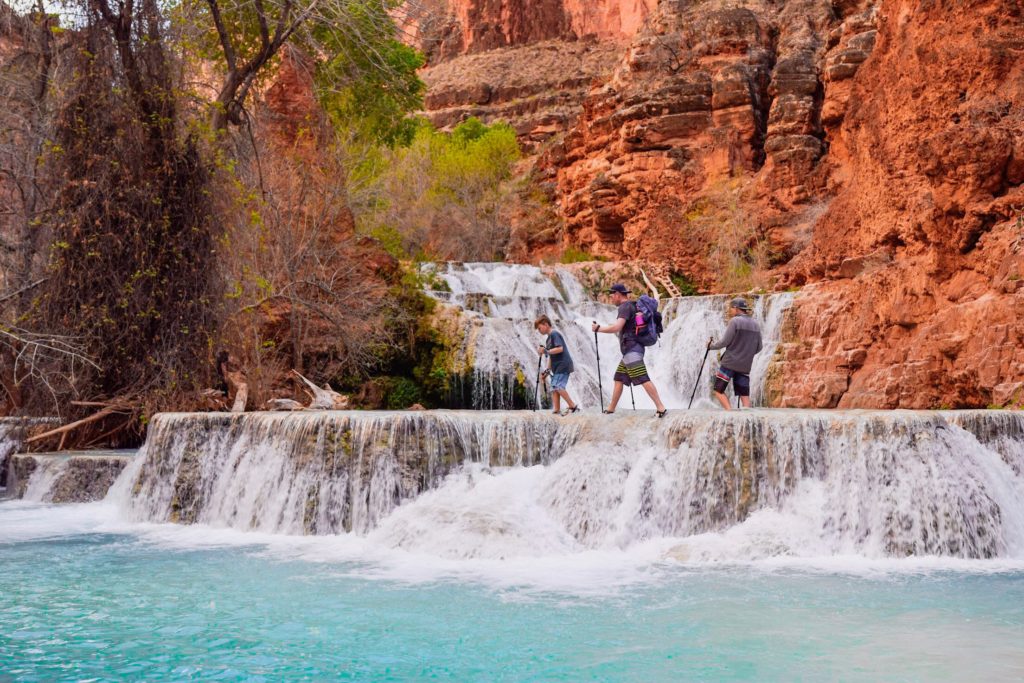
Trekking across Beaver Falls
Table of Contents:
Permits and Timing
The Hike
Sample Itineraries
What to Pack
Other Important Tips
Permits and Timing
Let’s start with the basics. How does one get a coveted permit to hike to Havasupai? This in fact, might be the most difficult part of the trek, being that permits are a hot commodity and in the past, nearly impossible to secure. Well, thanks to an online reservation system started by the Havasupai tribe in 2017 (who owns and manages the land), you can now book permits online! What’s the catch?
Because only a limited amount of permits are given each day, and because they are in high demand, it is best to reserve permits on the first day of February for that following year. For example, let’s say you want to book permits for June 2019. You would need to get online on Feb 1, 2019 at 8AM PST to reserve a spot for your desired dates (it might be a good idea to have some back-up dates too).
Keep in mind that permits for the entire year usually sell out within 20-30 min, so it’s best that you get online at 8AM on the dot! Also, make note that a 3 night minimum stay is required, no day hikes allowed.
For pricing, refer to the Havasupai reservations website. Also, if you don’t want to carry your gear, you can reserve a pack mule or helicopter to haul down your gear. We recommend using the helicopter to haul gear if you’re concerned about the animal’s welfare and also it’s cheaper!
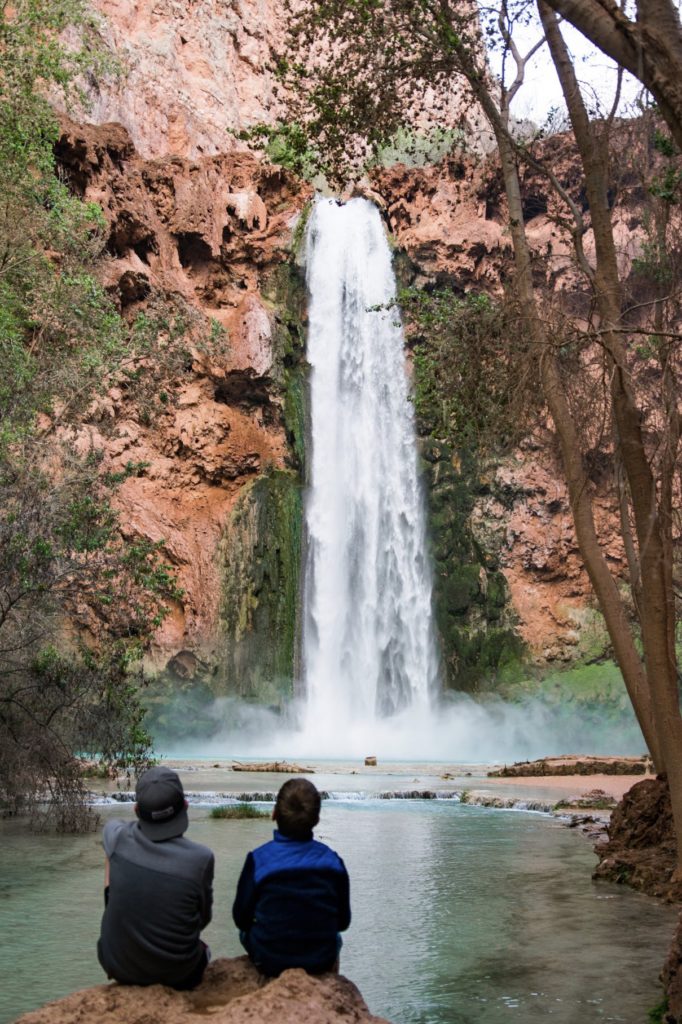
Enjoying the view at Mooney Falls.
The next hardest part in planning a trip to Havasupai is deciding on what time of year you want to go. Personally, we feel early Spring (March-April) or late Fall (Oct-Nov) is best if you want to avoid super hot temperatures (hiking in the heat is no joke!). If you go this time of year you will most likely encounter pleasant hiking temperatures, and the water stays about the same temp all year (right around 65 degrees), making it still nice to swim.
With that being said though, going in the Summer has its advantages too. Because it’s so hot outside, the water feels even more refreshing to swim, relax and wade in.
However, if you choose the warmer months to make this trek (May-Oct), it is advised to start super early (before the sun comes up) in the morning to make the trek down. (*Note: The hike from the parking lot/trail head to the village of Havasupai is approx 8 miles one way, and another 2 miles to the campground, so plan accordingly.) If temperatures are expected to exceed 100 degrees, many people start in the middle of the night to avoid hiking in the extreme heat where dehydration is common.
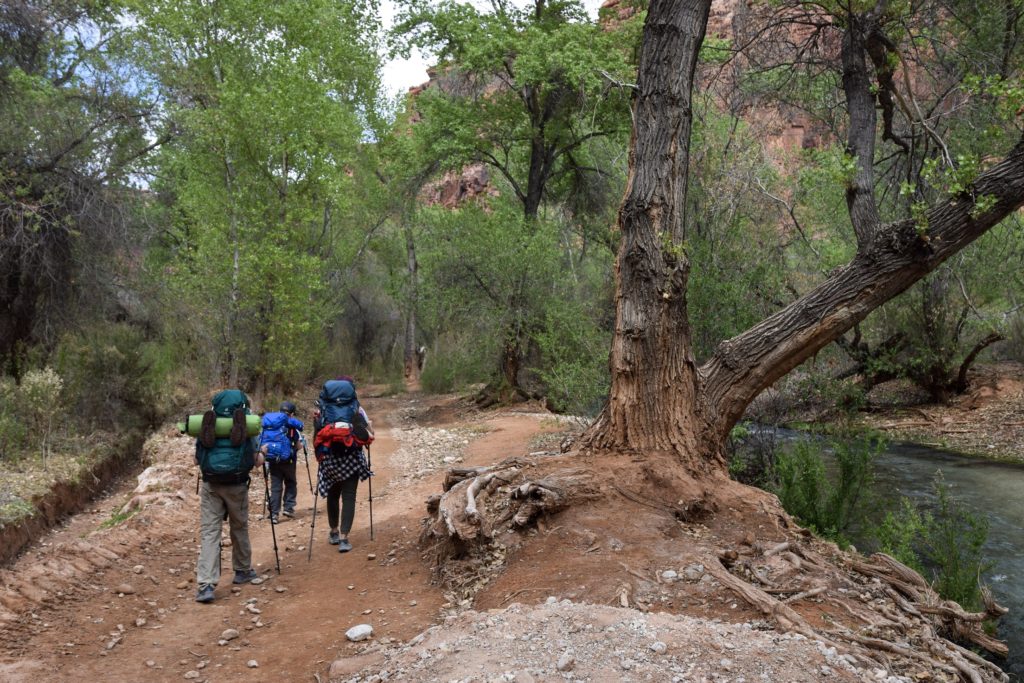
The trail to Havasupai follows the creek after the first 6 miles or so.
The Hike
Now, let’s talk about the hike. The trek to Havasu Falls is an adventure in it of itself. But first, do you have to hike? No! If you are physically unable to make the 10 mile trek to these falls, you can opt to reserve a ride on a helicopter if you want (one or both ways). Go here for directions on how to get to the Havasupai trailhead from Phoenix or Vegas (the closest major US cities).
But honestly, we think that the hike is well worth the effort (it is stunning the entire way!) and it makes for an accomplishment that you will never forget! The trail itself is only steep for the first 1.5 miles from the trail head going down the switchbacks. After that, the hike is pretty level with a slightly downhill slant.
So, if you consider that, hiking in is fairly easy especially if you pace yourself and take breaks every once in awhile. Hiking out will be a bit more difficult as you will do all the uphill leaving Havasu Falls back to the parking lot (climbing around 2400 feet in 9 miles). The trail is mostly rocky and sandy, so good shoes are a must. We strongly recommend hiking poles (even for the kids!), which will help you balance and hike more efficiently, while conserving energy.
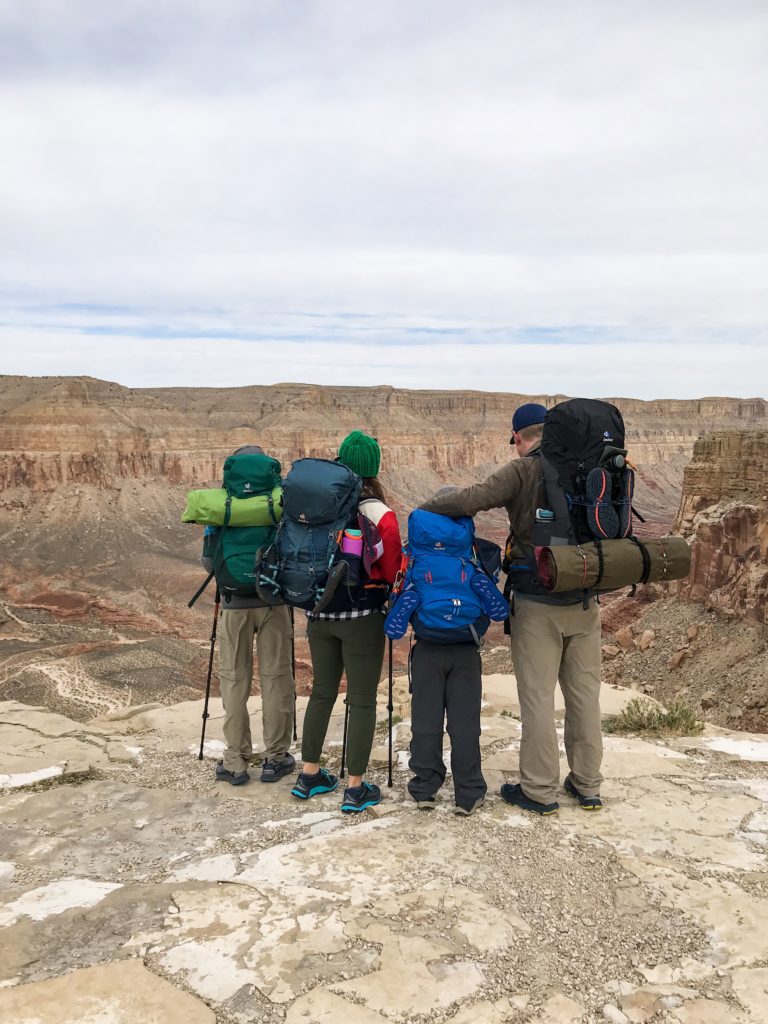
The start of the trail head, looking down the canyon.
As mentioned previously, it is 10 miles to reach the campground, so plan on it taking the majority of your day to get to/from the campground. There’s no water for the first 6 miles and daytime temperatures from May through September are often above 105 degrees Fahrenheit in the shade, so make sure you pack plenty of fluids. Once you reach the creek, you can filter water with your water filter.
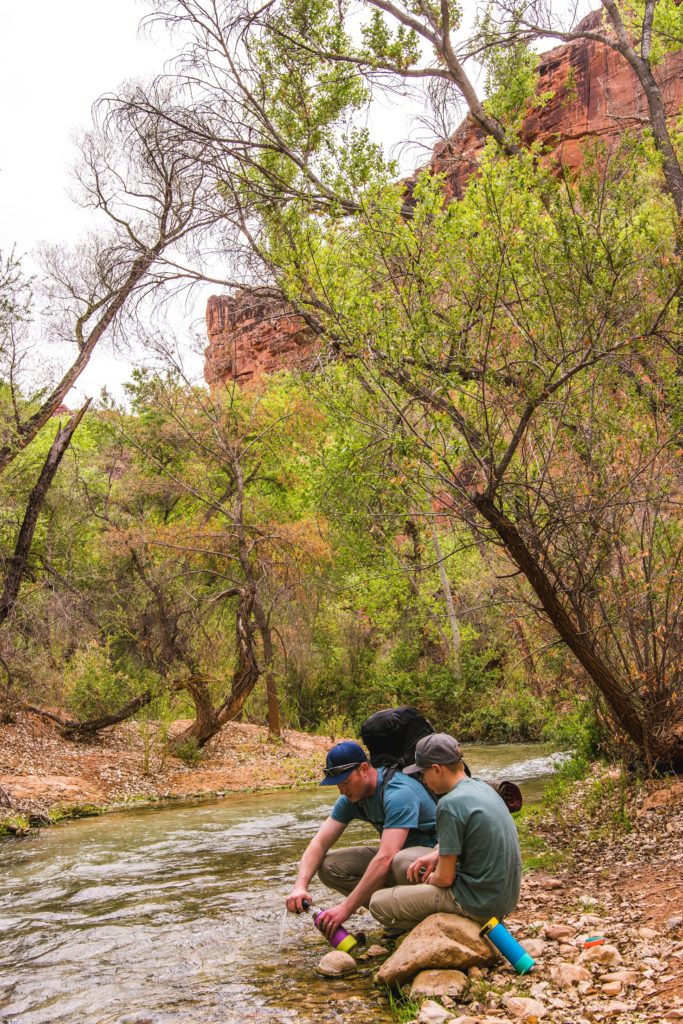
Filtering water at the creek. Because the water stays around the same temperature all year, it’s not super cold drinking water, but it’s what you’ve got!
When hiking with kids, whether you are carrying them or not, it’s important to stop often for rest breaks and snacks. Staying fueled and hydrated is super important on the trail! If your kids are carrying packs (more on that later), it’s even more important that you stop and let them take their packs off to rest a bit. We suggest taking a break each mile, or choosing a landmark up ahead to stop.
Keep rest breaks relatively short–10 to 15 min. In general, the longer you rest, the harder it can be to resume hiking sometimes (especially if you are sitting down) since muscle cramps can occur easily if you’re not careful. Check out our post on tips for hiking with kids to help your kids on the trail, while also making hiking more enjoyable for the whole family!
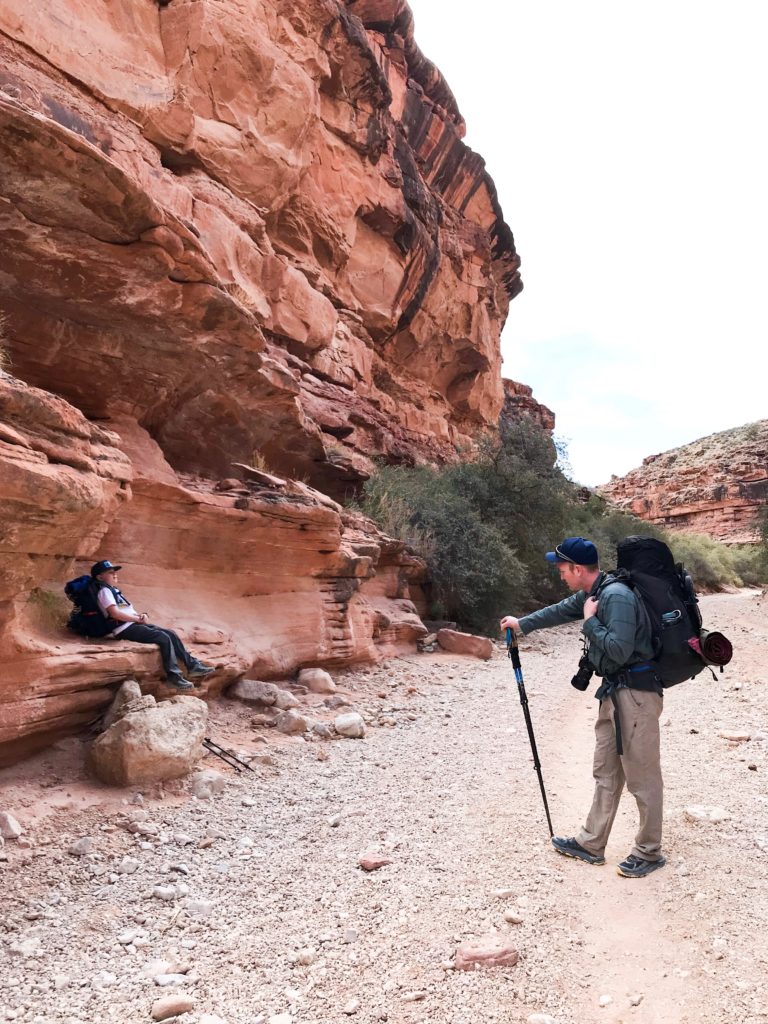
Breaks on the trail with kids are necessary to rest tired legs. Have some snacks or treats , such as gummy bears or sour patch kids as a good motivator!
There are several waterfalls that make up Havasupai. The main attractions are Havasu Falls, the most famous of all the waterfalls (located at the start of the campground) and Mooney Falls, the tallest of the falls (standing at 200 feet) and located at the end of the campground (a mile apart). There are also other waterfalls not to be missed such as Beaver Falls, an additional 5-6 mile round trip past Mooney Falls and worth the trip (this one was our favorite!), Fifty Foot Falls and Navajo Falls which are located before you reach the campground, and many other hidden gems worth exploring if you have the time.
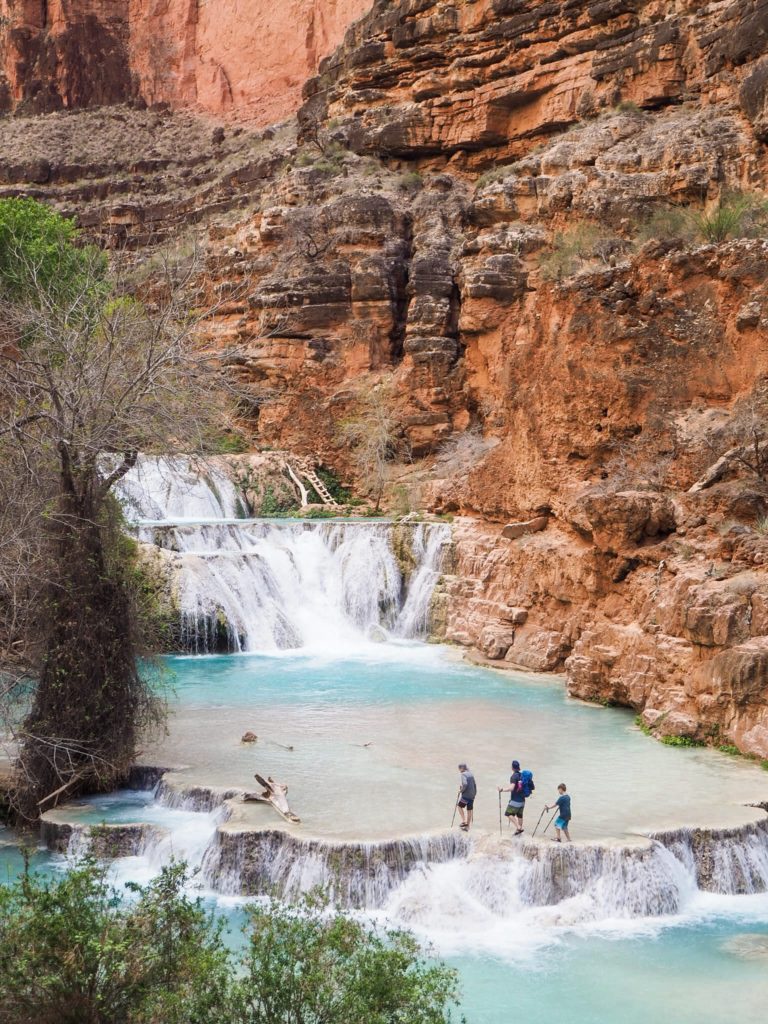
Beaver Falls was our favorite of the waterfalls and the best part was we had it all to ourselves!
A few notes and tips on the hike to Mooney and Beaver Falls. To get to Mooney Falls, which is located at the end of the campground (the top of the falls), you need to descend down a steep trail on a cliff, holding onto chains, climbing through a series of tunnels and caves, and lastly, down some very wet and slippery ladders. It might super sketchy, but if you take it slow and keep your kids close to you (always have an adult go first and last), it isn’t that bad and quite honestly, such an adventure!
Make sure to wear a rain jacket if the weather is cooler, as the mist from Mooney Falls will undoubtedly get you wet as you descend the ladders! It’s a good idea to do Mooney Falls in the morning too, before the crowds get here. Don’t miss the rope swing on the far side of the falls, hanging from a tree. There’s also a secret cave under the falls below the rope swing that is fun to explore. Our kids had a blast here!
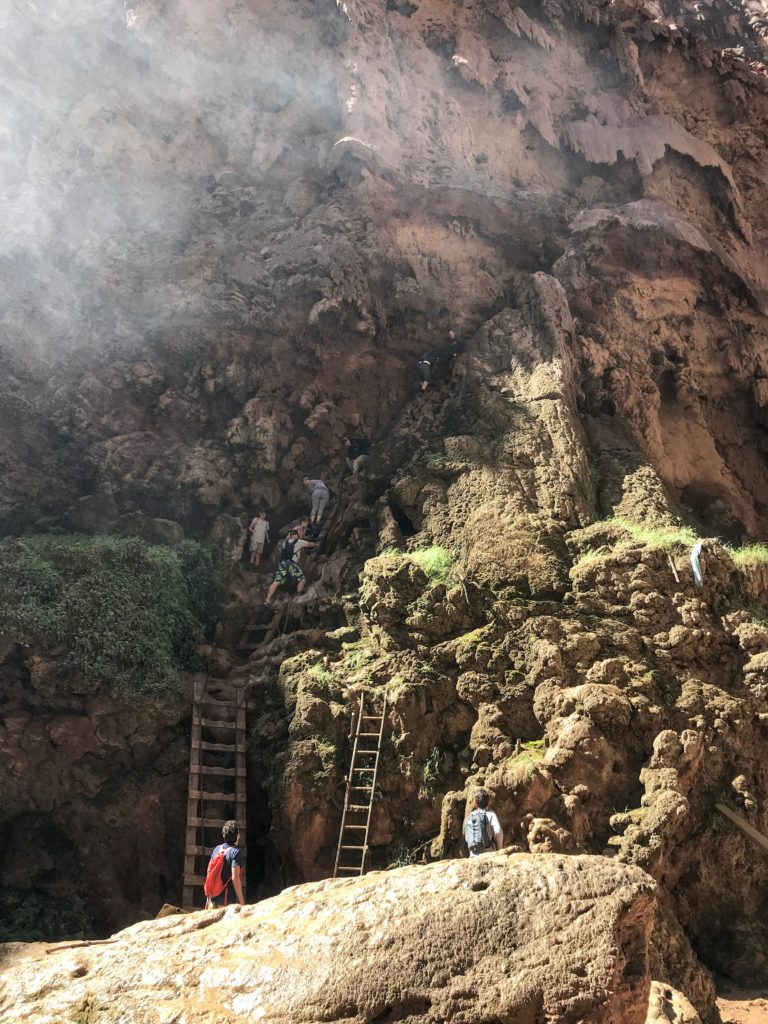
The descent down to Mooney Falls. You’ll feel like you’re in Indiana Jones!
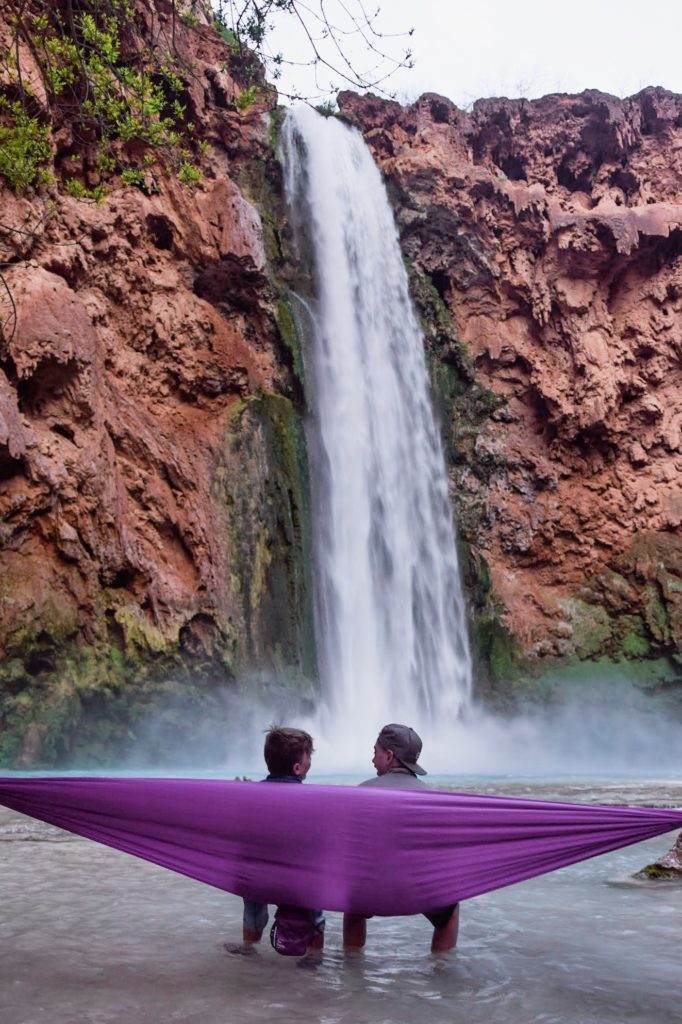
Relaxing from a hammock at Mooney Falls is a good way to experience these gorgeous falls.
Beaver Falls is about 3 miles one way from Mooney Falls. This is an easy hike, and so beautiful! It was our favorite section of hiking trail through Havasupai! As mentioned earlier, expect creek crossings along this trail, so it’s best to just wear water shoes or sandals with decent traction like Chacos or Keens. The trail meanders through a stunning canyon and requires some fun scrambling up and down numerous rocks and a few more ladders and primitive bridges.
If you do this hike fairly early in the morning, you will likely find yourselves the only ones on the trail, as it isn’t as popular to go beyond Mooney Falls. Before you get to Beaver Falls, you will hike through a cave with a lone palm tree and ascend a ladder up the trail. (Another option is to just follow the creek down to the top of the Beaver Falls from this point.)

You will cross Havasu Creek several times along the trail to Beaver Falls. That’s what makes it fun!

The trail to Beaver Falls is beautiful the entire way, with the tall red rock canyons looming overhead and the creek rushing through it.
Beaver Falls is a lot different than the other major falls. For one, it is a serious of smaller, cascading waterfalls with small pools separating them. It is even more gorgeous in person though and such a treat to get to. The pools here provide great swimming holes too, so bring your blow-up pool tubes! On the far side of the tallest waterfall, there is a place you can get out and climb up the rocks with a ladder.
We might not suggest this with small kids, but this is a fun route to take if you want to explore more, plus you can take this route back up the creek (walking through the water), all the way back up to where the trail meets again at the lone palm tree. Quite the adventure!
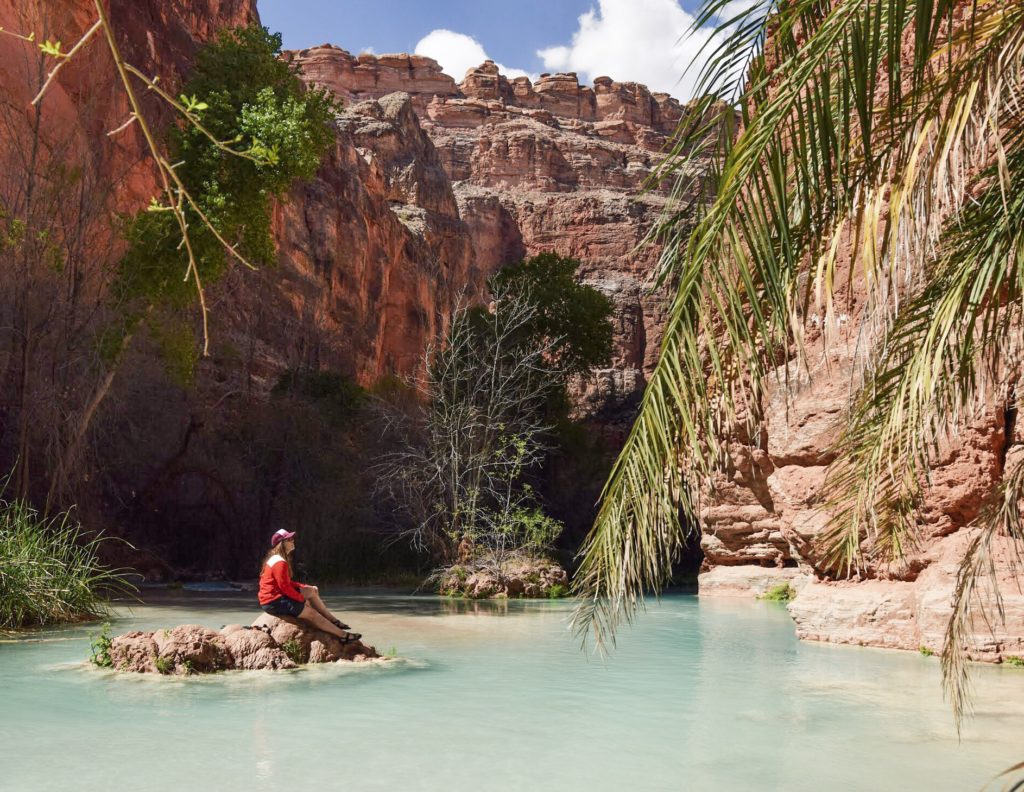
The section of the creek near the lone palm tree is gorgeous. You can also choose to access Beaver Falls this way by walking through the creek.

Bring some inflatable tubes for the kids to swim in at Beaver Falls. So fun!
Sample Itineraries
If you’re going to attempt Havasupai, do yourselves a favor and stay for at least two nights. We mentioned this earlier, but it’s worth mentioning again. Hiking in one day, only to hike out the next day isn’t the best way to experience and really enjoy all that Havasupai has to offer. In in our opinion, it’s not worth going (especially with kids!), if you can’t stay at least two nights and three days.
Itinerary 1: Two nights/Three days
This is probably the most common itinerary and what we chose to do, mostly because it was so expensive for our family of four with all the permits. If you choose this option, the majority of day 1 will be spent hiking into the campground. Depending on how fast you hike or even how early in the morning you leave from the trail head, use this day to also stop and see Fifty Foot and Navajo Falls briefly which are just past Supai, or the village where you check in.
The reason we suggest pit stopping at these falls on the first day (opposed to Day 2) is because they are on your way to the main falls and the campground, so you’re not adding mileage by backtracking. Both of these waterfalls have swimming holes and because they get a lot of direct sunlight, are usually the warmest too. Bearfoot Theory has some great tips and suggestions for exploring these falls.
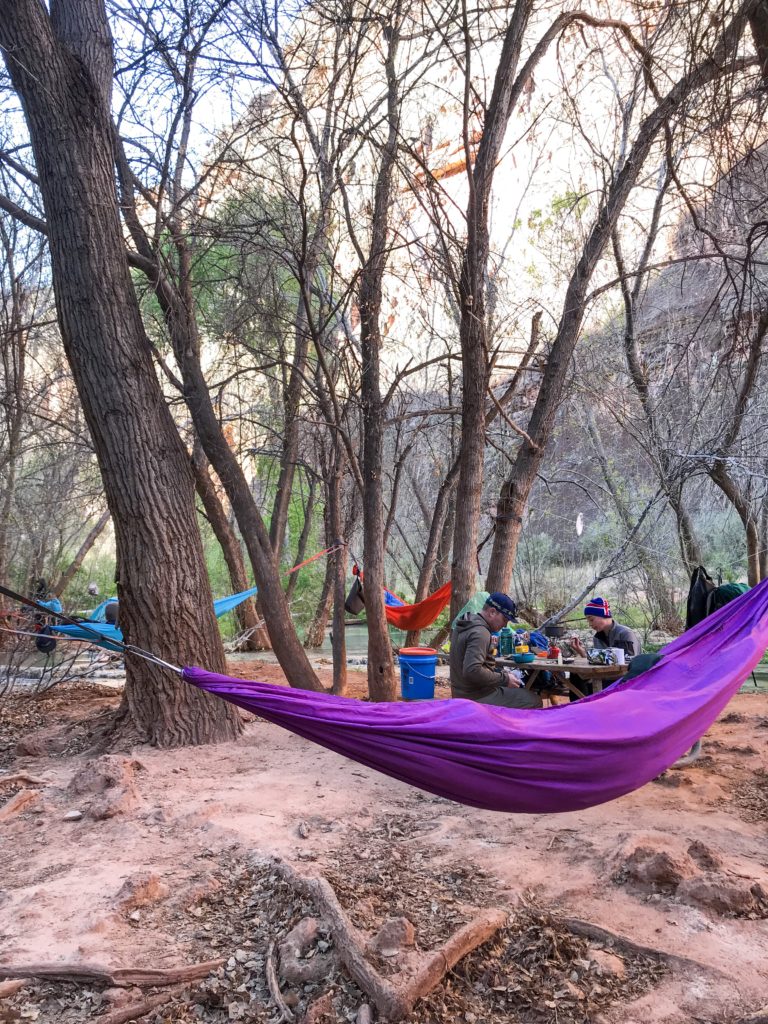
Our campsite, which was located right on the creek and near the end of the campground was perfect for hammock sleeping and listening to the sound of the rushing creek all night.
Once you reach Havasu Falls, you will want to spend some time here. There are several places to swim and it is a gorgeous place for a picnic. Don’t linger too long though, as you will need to find a campsite before dark. We were concerned that arriving in the evening would mean we wouldn’t find a good camping spot, but trust us, there are plenty of campsites and the campground is a mile long, so there is plenty of space.
Your initial inclination might be to quickly claim the first empty campsite you find, but hold out and keep walking towards the end of the campground. It gets prettier, there are more spots along the creek, more trees for shade (and hanging hammocks), and it is quieter.
Day 2, get up early and eat a good breakfast and aim to leave your campsite by 8 or 9AM to reach Mooney Falls (at the end of the campground) before other hikers arrive. Spend a couple of hours at Mooney Falls (remember it takes some time to descend down to Mooney Falls due to the cliffs), before hitting the trail to Beaver Falls. This hike will likely take the rest of the day (to get back to camp).
Day 3 is when you will hike out. We would advise getting an early start (even if it’s not hot) because it will take the entire day since it’s much harder hiking out. We stopped at Havasu Falls again on our way out, but that might be dependent on time and temperature.
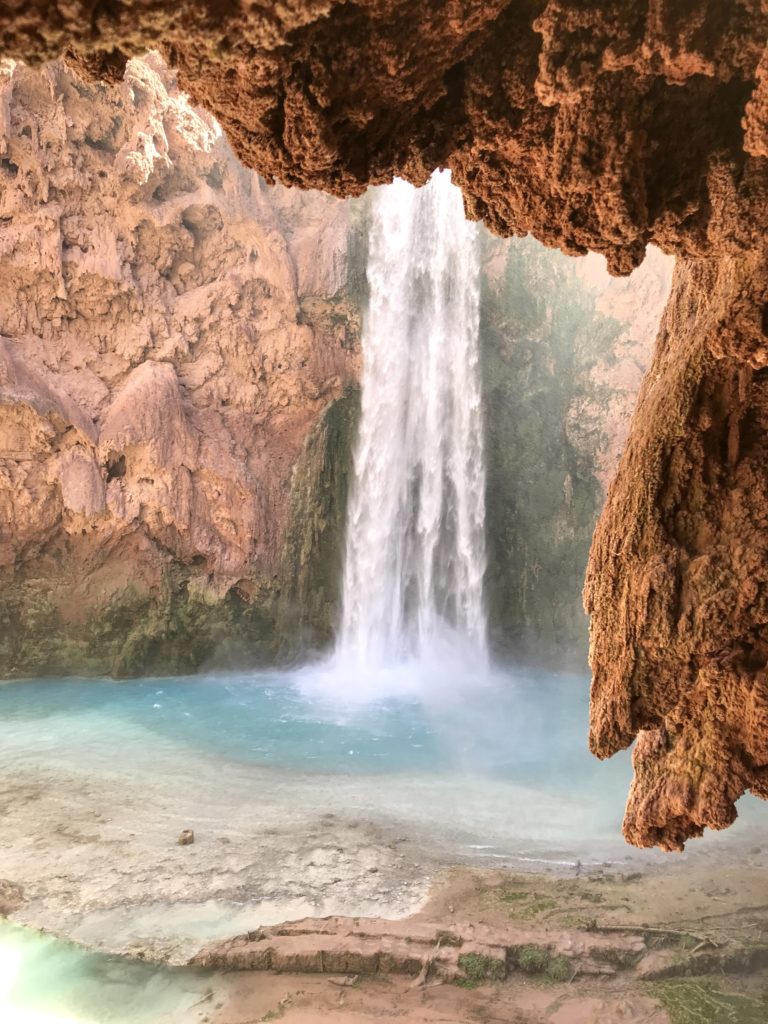
Mooney Falls, as seen along the trail down the cliffs.
Itinerary 2: Three nights/Four days and beyond
With this itinerary, you will have a bit more time to enjoy all of the waterfalls longer. After spending Day 1 hiking in, reward yourself with a swim at Havasu Falls. Day 2 is spent hiking to Mooney and Beaver Falls, while Day 3 is all about exploring Fifty Foot and Navajo Falls. Use this day to just relax and swim or explore some other lesser-known waterfalls, such as Hidden Falls. On Day 4, you are hiking back out.
If you have at least four days and can afford to put some more mileage on your legs, another popular trek to add is the hike to the Confluence. The Confluence is where Havasu Creek meets the Colorado River along the Grand Canyon. This adds on another 16 miles though, so it’s best to do this with adults and/or older kids that are up to it! To get there, you simply continue past Beaver Falls for another 5 miles. If you choose to do the Confluence, we’ve heard it’s wise to do this on the same day you do Beaver Falls (starting super early).
What to Pack
Now comes the most important part. Packing. The gear. And all that fun and necessary stuff. When it came to preparing for the actual trip, this is where we spent the most time planning and preparing. Because this was our boys’ first long backpacking trip, we wanted to be super prepared and also make their packs as light as possible.
When you are packing your gear at home, it’s important to weigh your packs (even with water) so that you know how much weight you’re carrying and what to take out if necessary. We kept our packs between 25-35 lbs and the kids packs between 15-20 lbs (pack even lighter if kids are younger or inexperienced). Download and print our Havasupai Packing List.
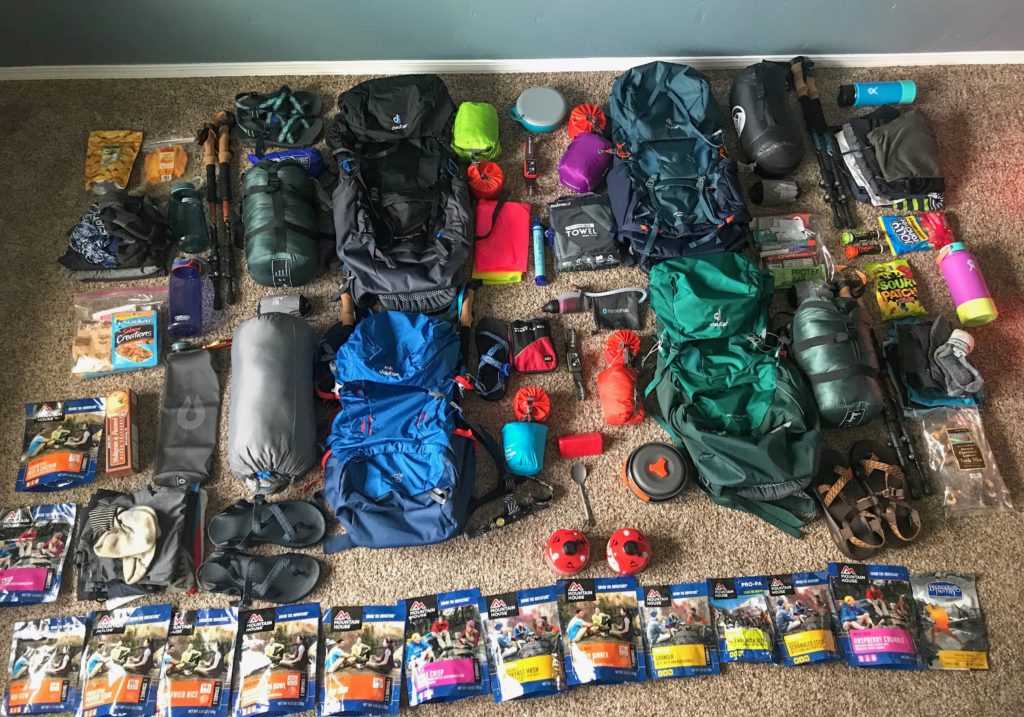
All the gear! Being organized when preparing for a backpacking trip is key.
Backpacks
Make sure you have a good backpack that is supportive, the right size for your frame, and comfortable to wear for long periods of time. We love the Deuter Air Contact Lite series because they have a lightweight internal frame, a ventilation system, load adjustment straps, a padded hip belt, and lots of cool pockets and features. If you aren’t sure what size you or your kids need, go to REI to be fitted (even if you don’t buy backpacks there). We carried the Air Contact Lite 65+10 and the Air Contact Lite 60 +10 SL (women’s fit), and our boys carried the Air Contact Lite 50+10 and the kids Fox 40 backpack.
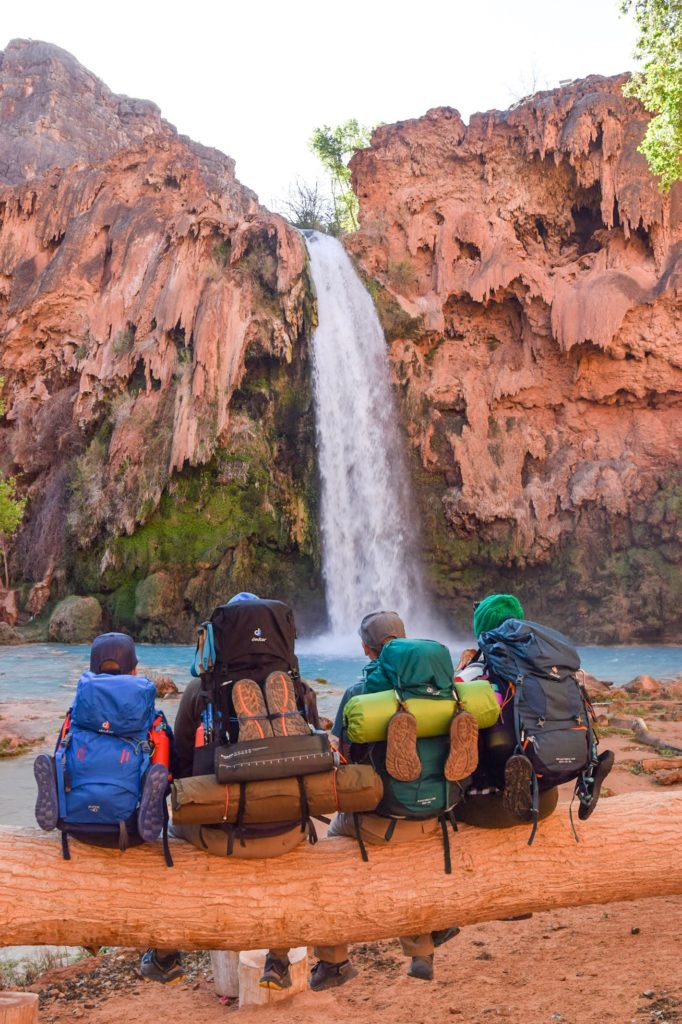
With some smart planning, you can pack your backpacks fairly light without breaking the budget.
Tent or Hammock?
This might be the hardest decision when packing for Havasupai–deciding what to sleep in. If you are going to Havasupai during warmer months (March-Nov), it’s wise to just skip the tent and sleep in a hammock. Hammocks are lighter weight and take up less space than a tent (plus there are plenty of trees at the campground!). We each got hammocks from Kammok (the Roo Single for the kids and the Roo Double for the adults), and it was perfect!
These hammocks weigh less than 1 lb and take up hardly any space in your pack. They are also super easy to put up and come with adjustable straps (we suggest getting the 15 ft straps for more length). Also, don’t try to sleep more than one person per hammock! It will make for a more comfortable sleep. The only exception to this is if you have a small toddler or baby with you.
If you are going when there’s a chance of rain (watch the forecast), it’s a good idea to bring a rain fly for the hammocks just in case. Kammok makes a good all-weather rain fly, or you can get this Bear Butt rain fly on Amazon. Don’t worry about getting a rain fly for each hammock, you can always stack two hammocks on top of each other!
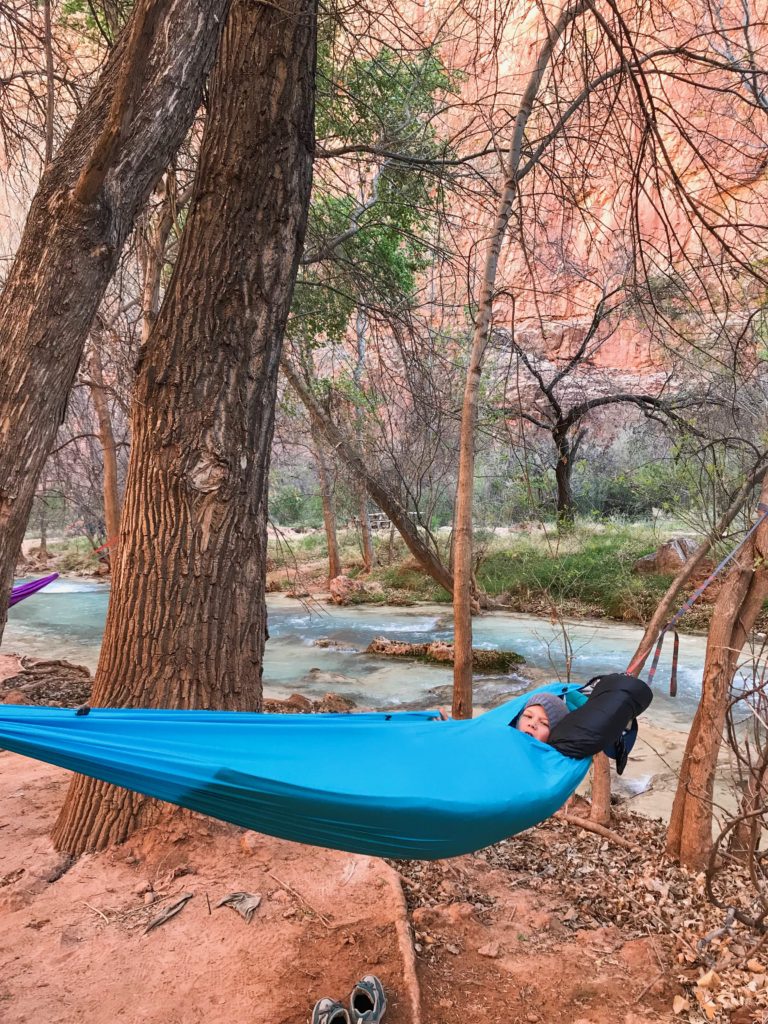
Snug as a bug in a rug
If you choose to sleep in a tent, there are some great, economical and lightweight options that are ideal for backpacking such as the Nemo Hornet 2P tent or our personal favorite, the Big Agnes Copper Spur HV UL 2 tent, both weighing around 2 lbs! If you have kids with you, each adult might have to carry a tent to avoid packing a bigger, heavier tent.
Sleeping Essentials
Having a high quality sleeping bag is essential and generally speaking, a bag that goes down to 20 or 30 degrees should suffice for camping at Havasupai. In the summer months, you certainly don’t need a bag with this temperature rating, but we suggest having one that goes down to 20-30 degrees just for versatility. As for lightweight sleeping bags, we love the Nemo sleeping bags because they are lightweight and a good price point. Plus, they come with a compression stuff sack which is a must for backpacking.
A good sleeping mat is required too, regardless if you sleep in a tent or hammock for good insulation and padding. We debated bringing mats on our trip, but ultimately we did because when you sleep above the ground, it’s much colder (up to 20 degrees cooler!).
Mats also make hammock sleeping more comfortable (especially for most adults!). We love Big Agnes sleeping pads because they are lightweight, compact and blow up/take down fast. Plus, they are super comfy! The Air Core Ultra is a great option and also affordable, and the Insulated AXL Air is an awesome 3-season solution that offers even more padding without the extra weight (voted one of the best mats for backpacking!).
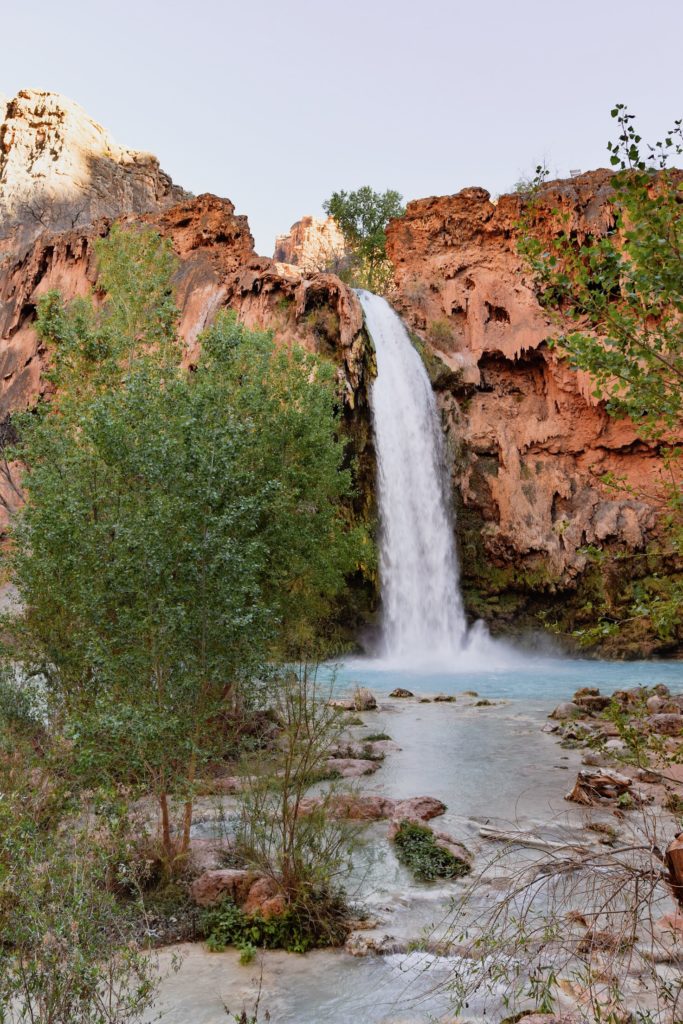
Havasu Falls
A good camping pillow is a must for hammock or tent sleeping and we found these lightweight Hikenture pillows on Amazon that are super cheap, but awesome! They take up hardly any space and are easy to inflate. If you decide to hammock sleep and don’t have a super warm sleeping bag or if you go during the colder months, it might be a good idea to bring an emergency blanket for extra insulation or a down blanket like our favorite Rumpl camping blanket! These are amazing and keep you warm and cozy. We’ve even heard of people sleeping with only a down blanket in a hammock in the hot summer months!
Food & Water Essentials
When you go backpacking, you have to bring a lightweight backpacking stove to cook your food like best-seller Jet Boil or our personal go-to, the MSR Pocket Rocket. Keep in mind that you will need to bring propane too, and if you’re not sure how much propane you need (because it depends on how often you use your stove, how many liters of water you’re boiling, etc), call your local REI and ask a camping expert or check out this blog post on calculating how much propane you need.

The trail to Beaver Falls has all sorts of hidden gems.
If you’re mostly eating backpacking food such as our favorite, Mountain House meals (which we’ve found to be the best tasting and most economical), you can skip bringing the full mess kit (and eat straight out of the bag!) and just bring eating utensils such as this lightweight, titanium spork or even this awesome multi-tool.
You’ll need a good water filter too since the only drinking water in Havasupai can be found at the spring in the campground. We love the MSR Trail Shot water filter because it’s super small (you could literally fit it in your pocket) and easy to use. This MSR Mini Works water filtration system is good too, and it’s always a good idea to have a back-up like a Life Straw in case your water filter fails.
In addition to a water filter, bring plenty of water bottles and even a water storage container like this MSR Dromedary 6L bag or if you don’t want to carry that much water, the HydraPack Seeker 3L collapsible bag (which is what we used). As far as water bottles go, people will argue not to bring heavy water bottles like Hydro Flasks, but we prefer cold water (since Hydro Flasks keep your water cold up to 24 hours) and so it was worth carrying a little extra weight in our water bottles. We love the 24 and 32 oz size water bottles the best.
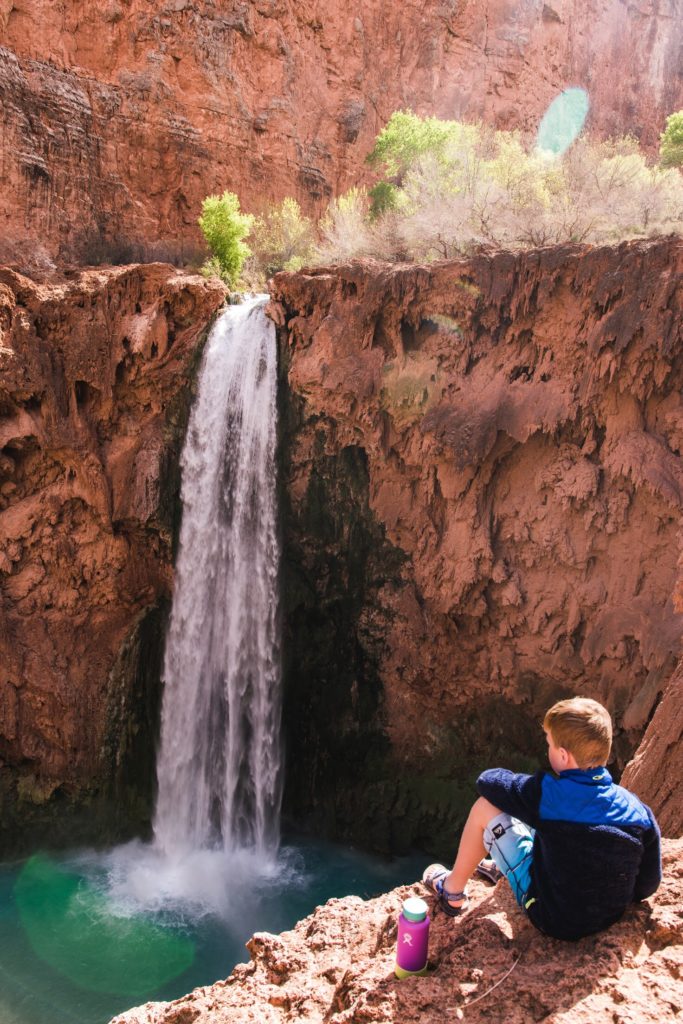
We don’t go anywhere without our Hydro Flasks.
Other Packing Essentials
It’s wise to bring a stuff sack or a luggage cube to store your clothes, mostly so you can keep them together, but also in case anything gets wet, you can put damp clothes in there. We love Sea-to-Summit stuff sacks and for luggage cubes, you can’t go wrong with Jet Pal travel organizer since they are lightweight.
If you plan to swim, make sure to pack a quick-dry microfiber towel like this Rain Leaf backpacking towel (we got the extra large size). You will also need to bring a headlamp for each person such as the Black Diamond 300 Lumen headlamp.
Since squirrels are a BIG problem at Havasupai (trust us, they are ravenous and will chew through your tents and backpacks to get any food), it is absolutely ESSENTIAL to bring a rat sack or even better, a ruggedized dry bag to store all your food in (we bought the 20L because it fits more food). It’s also a good idea to bring odor-free garbage bags to keep critters and bugs out of your trash.

You must hang your packs and food on rope or paracord between trees at your campsite to keep the squirrels and other animals out of your food.
We’ve included all other necessary items such as a clothing essentials, first aide kit, para-cord or rope, and more in our Havasupai Packing List.
Other Important Tips
1. Do not over pack. We stated this earlier, but we can’t reiterate this enough. To avoid over packing or making your packs too heavy, consider wearing the same clothes the whole time. We basically wore the same clothes for 3 days minus swim suits, base layers to sleep in, and an extra pair of socks and underwear.
Think lightweight layers such as thermals, down jacket, etc. Also, don’t forget a beanie if you’re going during the colder months! Only bring necessities and try to save weight as much as you can with things like sleeping bags, a tent or hammock, mat, clothes etc. Every ounce counts!
When it came to our packs, the food weighed the most, so make sure you bring lightweight snack and food items such as backpacking meals, instant oatmeal, and tuna packets instead of canned goods or other heavier food items. Make sure when you disperse the food and snacks that you give your kids the lightest food items to carry (or no food at all). If you’re worried about running out of food, there is a general store at the village if you need to pick up anything.

Keeping packs as light as possible is key!
2. Pack smart and bring foods that the whole family enjoys. Kids need extra motivation on the trail sometimes, so sometimes you’ve got to pull out all the stops! Some of our go-to snacks are Trader Joe’s dried fruit and trail mix, beef (or chicken) jerky sticks, G2G protein bars, tuna packets with crackers, Jolly Ranchers (we like them because they last longer), Sour Patch Kids, Gummy Bears, even lollipops! Because you will be losing a lot of water through sweat as you hike, it’s important to replace your electrolytes. We like to add in our water, Nunn Hydration tablets or Zip Fizz (also great for a boost of energy!).
3. Camp in the parking lot next to the trail head, so you can get an early start on the trail. But if you would rather sleep in a bed, you can book a room at the Hualapai Lodge about 60 miles away in Peach Springs. We camped right beside our car and it wasn’t the best night sleep with the wind howling all night, but it worked!

4. Bring Ibuprofen for sore muscles and joints. We each took some Tylenol at the end of each day and felt great the next day. No achy joints and muscles!
5. Put some Glide on your feet. This is to avoid blisters, so your feet don’t chafe or rub inside your socks/shoes! And if you start to get a “hot spot”, slap some moleskin or even duct tape on it! There are also some great blister gel band-aids that work great too.
6. Consider wearing trail running sneakers instead of hiking boots. This is not to say that hiking boots aren’t great, but if you’re not used to wearing boots, good trail running shoes might offer better arch support. We loved our Vasque Trailbender shoes. They were supportive, comfortable and no one got blisters!
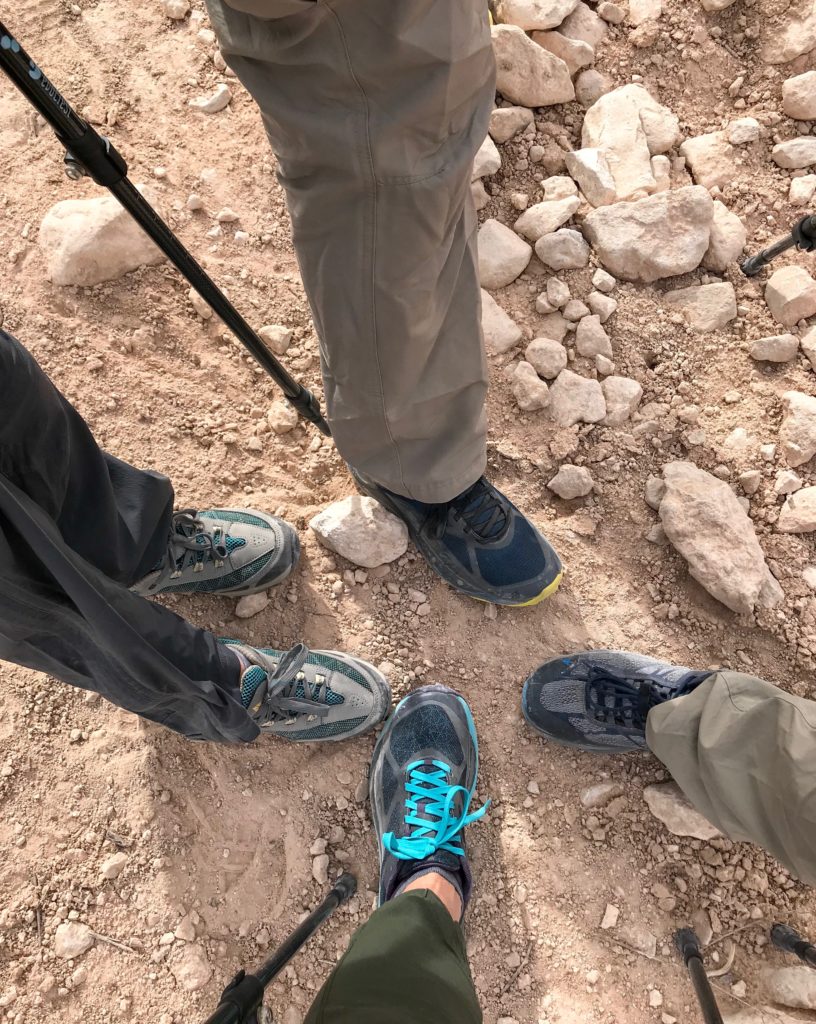
We opted to wear trail running shoes with great arch support for this hike. It was a good choice!
7. Bring a small backpack to carry food/water and necessities for day hikes. Or empty out your gear out of the smallest pack and leave everything else back at camp.
8. Grab a bucket at your campsite. When you reach the campground on the first day, keep your eyes peeled out for an unused 5 gallon bucket (provided by the Havasupai tribe) to store your food and anything with a scent. There are only a limited amount of buckets, however, so don’t bank on getting one (and hence why you should bring a ruggedized dry bag).
It’s important that you hang everything, (including the bucket and dry bag) when you leave the campsite for the day (and even at night when you’re sleeping) to keep the pesky critters out.
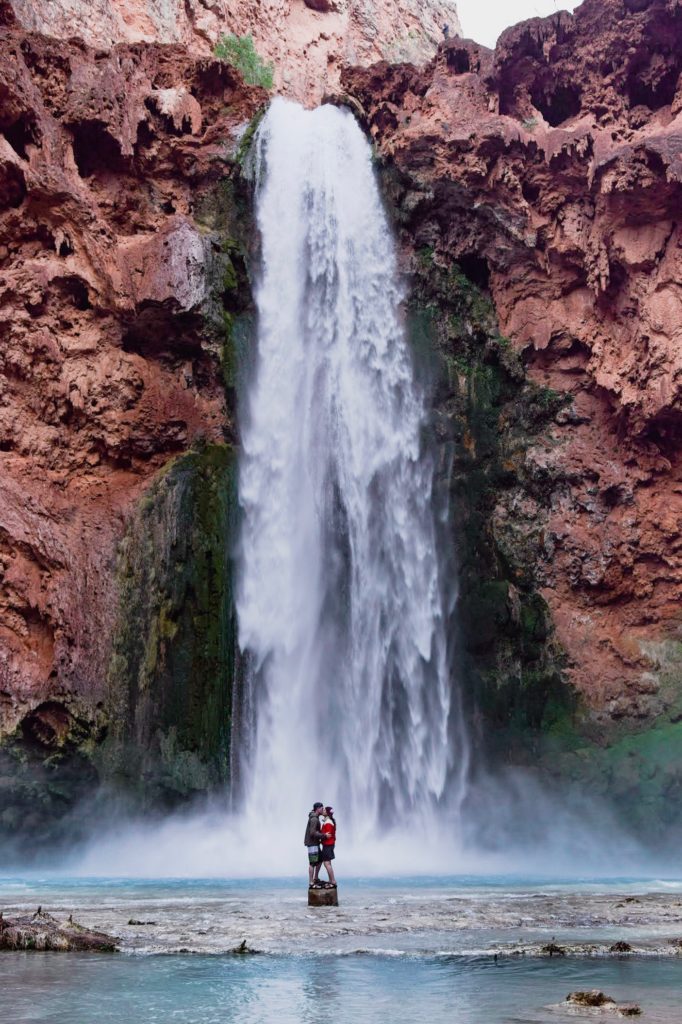
Seemed like a good photo op for a smooch.
9. Have some games you can play on the trail with kids. When you’re hiking with kids, you will need to pass the time quickly and we’ve found that games are a great way to distract them. We love the alphabet game, “I’m going on a picnic (or hike) and I’m going to bring…”, the “Would you rather…” game and of course, the ever-popular “I Spy” game. It’s amazing how time flies when you’re having fun and carrying on a conversation.
10. Bring trekking poles! These were a game changer to us in so many ways. They helped us balance on loose rocks along the trail, cross the creek, and made hiking uphill easier. Basically, hiking poles will make you more efficient and take some load off of your joints.
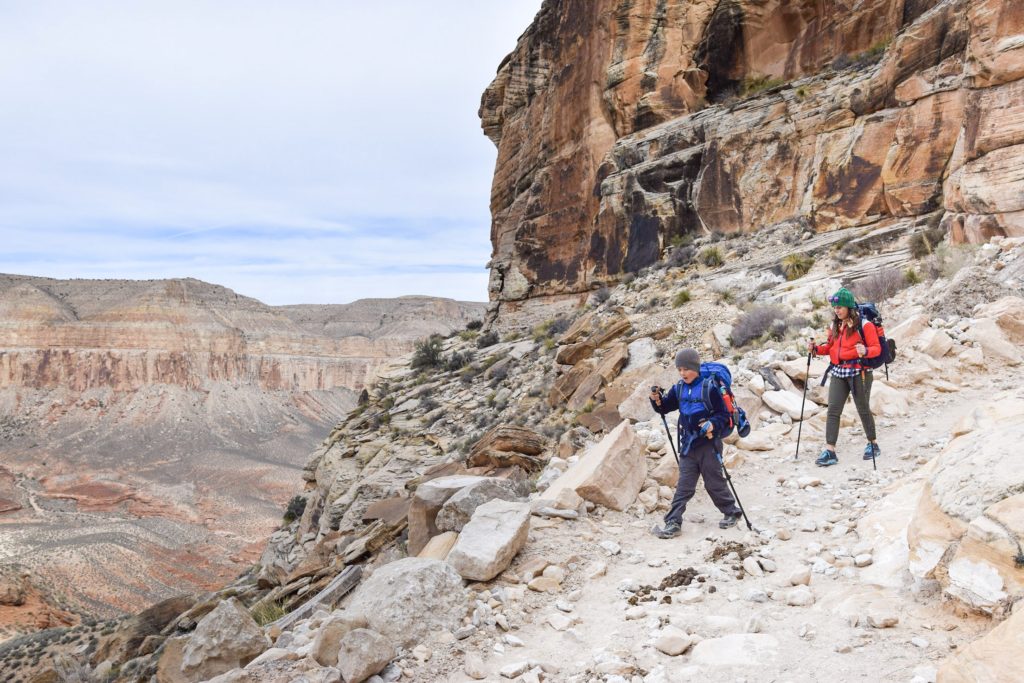
Trekking poles help you uphill and downhill.
11. Keep some snacks and cold beverages back at your car. This way when you finish the hike, you will be rewarded! We left frozen Gatorade in a cooler in our car and when we got done, it was thawed but still cold! So refreshing!
12. Be friendly and respectful with the local tribe. We met so many kind and wonderful people in the village, and it was worth stopping and learning more about their culture and the history of their land.
13. LEAVE NO TRACE! Pick up your trash and if you see trash on the trail, pick it up too. This is a beautiful land and we should respect it, so do your part and keep it pristine. Enough said.
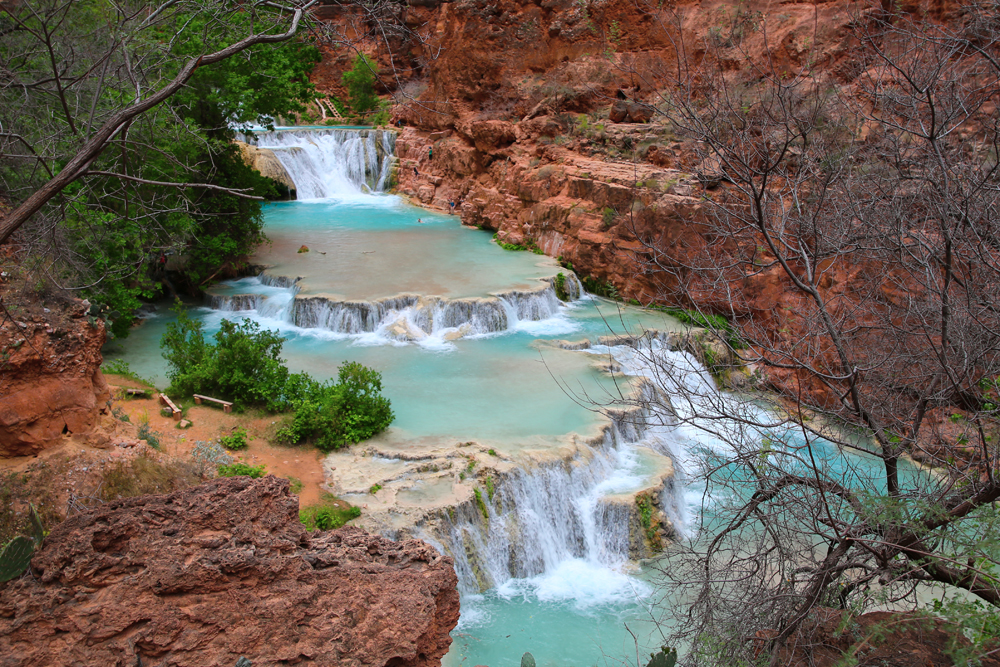
Would you want to see this place covered in trash? Let’s keep this beautiful land and water clean and pristine.
14. Pack flotation tubes for some extra fun in the water. Your kids and you will enjoy relaxing in the pristine blue waters beneath the falls and in the creek.
15. Don’t bring a drone. They are prohibited here. As for other camera equipment, make sure to bring extra batteries, and only bring the necessities (such as one extra camera lens). We skipped the tripod because of weight, but if you must bring a tripod, bring a lightweight one.
16. Make sure to stop in the Supai village. On your hike out, you have to try the delicious Navajo tacos or fry bread! Or ice cream if it’s hot outside!
17. HAVE FUN and make amazing memories with your kids! Don’t rush the experience, take your time and allow your kids to fully appreciate this incredible place and accomplishment they’ve made!
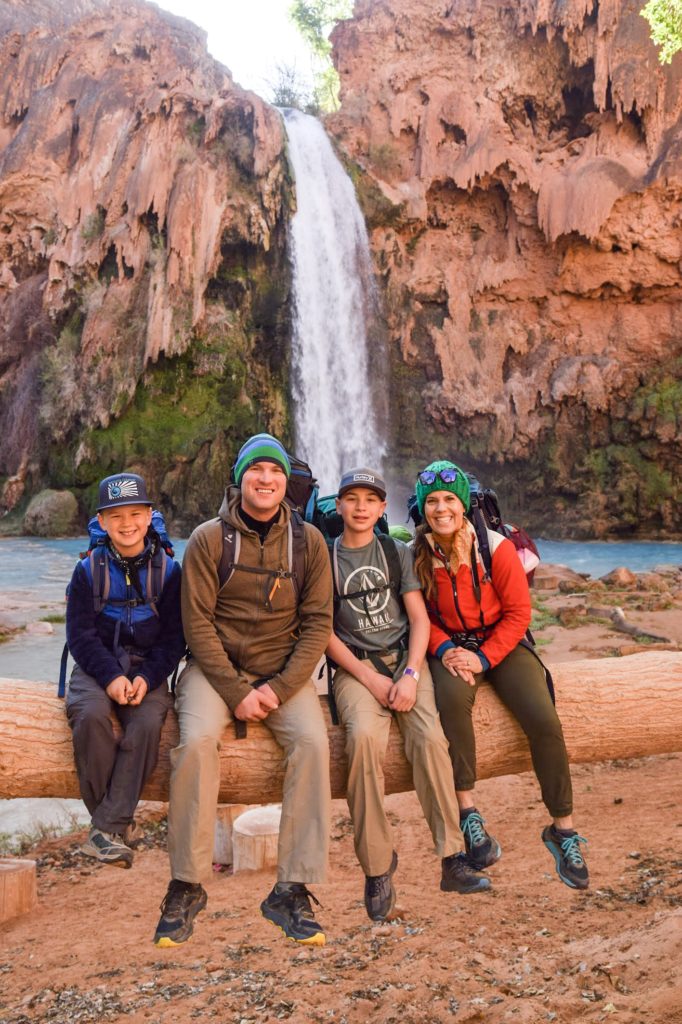
Have you done Havasupai yet? Add it to your bucketlist if you haven’t yet. You can also make a road trip out of it and visit some nearby national parks. Another option is to head to Southern Utah and try some of these amazing day hikes and outdoor adventures in St. George!
